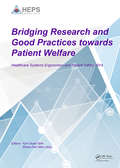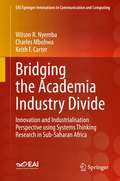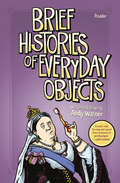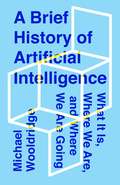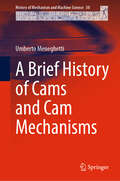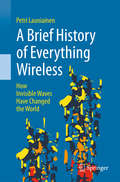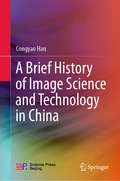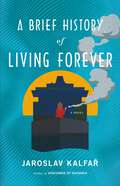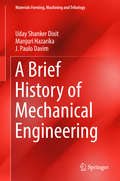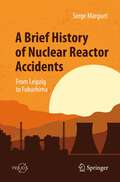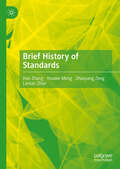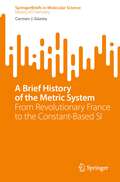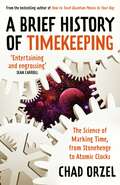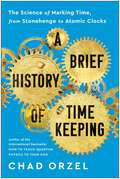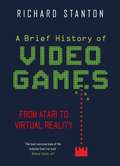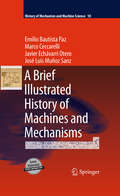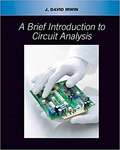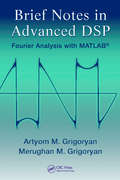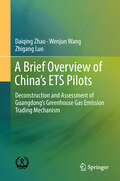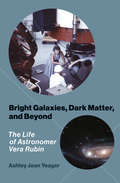- Table View
- List View
Bridging Research and Good Practices towards Patients Welfare: Proceedings of the 4th International Conference on Healthcare Ergonomics and Patient Safety (HEPS), Taipei, Taiwan, 23-26 June 2014
by Yuh-Chuan Shih Sheau-Farn Max LiangErgonomics is a human-centered discipline. This is particularly true for healthcare systems and patient safety where the human‘s well-being will undergo critical impacts if solutions are not properly designed and practiced. Effective handling of these concerns involves knowledge from healthcare work (e.g., shift work, patient handling, and medical
Bridging the Academia Industry Divide: Innovation and Industrialisation Perspective using Systems Thinking Research in Sub-Saharan Africa (EAI/Springer Innovations in Communication and Computing)
by Wilson R. Nyemba Charles Mbohwa Keith F. CarterThis book is the result of years of research following a realization of the mismatch of engineering skills produced by universities and those that industry required, based on the situation in Sub-Saharan Africa, equally applicable to other regions in Africa and indeed worldwide. The book is meant to assist engineering academics and engineers in industry to build capacity and cope with the dynamic trends in technology brought on by the 4th Industrial Revolution and to prepare for the 5th Industrial Revolution, an era predicted to be dominated by critical and system thinkers with creative and innovative skills as basic necessities. The book is also useful for policy-making researchers in academia, industrial and public sector researchers, and implementers in governments that provide required funding for the development of human resources and skills. The book primarily consists of the novel research and innovation approaches of modelling and building systems thinking sub-models which were ultimately integrated into the Universal Systems Thinking (UST) model aimed at improving the quality of engineers and engineering practice. The initiatives in this book include strategies for bridging the gap between industry and academia through systems thinking research. The book provides information on how to model, simulate, adjust and implement integrated systems thinking approaches to engineering education and training for capacity building and sustainability. The book also covers approaches to address research gaps and mismatch of skills while capitalizing on the successes of several projects carried out and supported by the Royal Academy of Engineering over the years.
Bridging the Strait: The Story of The Confederation Bridge Project
by Copthorne MacdonaldJune 1997 marked the opening of the Confederation Bridge which spans the Northumberland Strait and connects Prince Edward Island to New Brunswick. The bridge, designed and built by the international consortium Strait Crossing, is one of the most innovative engineering projects undertaken in Canada. It is the longest bridge ever constructed over ice covered water and one of the longest continuous multi-span bridges in the world. Bridging the Strait describes the arduous trips taken by ice boats, ferries, steamers and ice breakers which have been the link to PEI. The author, Copthorne Macdonald, traces the events leading up to the building of the bridge. He explains the problems faced by the Strait Crossing team, and tells the story of how they overcame challenging obstacles such as ice, wind and treacherous ocean currents. The stunning achievement of the Confederation Bridge is celebrated in this handsome book. It highlights the contribution of Strait Crossing, and Public Works Canada, who steered the project from conception to completion, and it provides a fitting tribute to the engineers and designers who solved the technical problems and the workers who sacrificed to bring the project to fruition.
Brief Histories of Everyday Objects
by Andy WarnerNOW A NEW YORK TIMES BESTSELLER Hilarious, entertaining, and illustrated histories behind some of life's most common and underappreciated objects - from the paperclip and the toothbrush to the sports bra and roller skatesBrief Histories of Everyday Objects is a graphic tour through the unusual creation of some of the mundane items that surround us in our daily lives. Chapters are peppered with ballpoint pen riots, cowboy wars, and really bad Victorian practical jokes. Structured around the different locations in our home and daily life—the kitchen, the bathroom, the office, and the grocery store—award-nominated illustrator Andy Warner traces the often surprising and sometimes complex histories behind the items we often take for granted. Readers learn how Velcro was created after a Swiss engineer took his dog for a walk; how a naval engineer invented the Slinky; a German housewife, the coffee filter; and a radical feminist and anti-capitalist, the game Monopoly. This is both a book of histories and a book about histories. It explores how lies become legends, trade routes spring up, and empires rise and fall—all from the perspective of your toothbrush or toilet.
A Brief History of Artificial Intelligence: What It Is, Where We Are, and Where We Are Going
by Michael WooldridgeFrom Oxford's leading AI researcher comes a fun and accessible tour through the history and future of one of the most cutting edge and misunderstood field in science: Artificial IntelligenceThe somewhat ill-defined long-term aim of AI is to build machines that are conscious, self-aware, and sentient; machines capable of the kind of intelligent autonomous action that currently only people are capable of. As an AI researcher with 25 years of experience, professor Mike Wooldridge has learned to be obsessively cautious about such claims, while still promoting an intense optimism about the future of the field. There have been genuine scientific breakthroughs that have made AI systems possible in the past decade that the founders of the field would have hailed as miraculous. Driverless cars and automated translation tools are just two examples of AI technologies that have become a practical, everyday reality in the past few years, and which will have a huge impact on our world.While the dream of conscious machines remains, Professor Wooldridge believes, a distant prospect, the floodgates for AI have opened. Wooldridge's A Brief History of Artificial Intelligence is an exciting romp through the history of this groundbreaking field--a one-stop-shop for AI's past, present, and world-changing future.
A Brief History of Cams and Cam Mechanisms (History of Mechanism and Machine Science #50)
by Umberto MeneghettiThis book offers a description of the evolution of cams and their uses from the Middle Ages to the present day, highlighting their contribution to the development of technology. Usually, in the history of technology the diverse types of machines are taken into account, but the importance of cams is not emphasized, which are often fundamental for the operation of such machines. In this book the focus is instead on cams, understood as important, and often essential, components of machines that have had significant importance in the development of technology. It treats technical aspects at a level easily accessible even to non-experts in mechanics and the various applications are illustrated with many figures. The book serves as a reference work for those interested in both the history of technology and machines in general, and it helps them deal with certain mechanical problems, even starting from solutions already obtained with cams and, perhaps, overcoming them with others suggested by current developments in technology.
A Brief History of Everything Wireless: How Invisible Waves Have Changed the World
by Petri LauniainenSince the discovery of electromagnetic waves less than 150 years ago, the application of wireless communications technology has not only revolutionized our daily lives, but also fundamentally changed the course of world history.A Brief History of Everything Wireless charts the fascinating story of wireless communications. The book leads the reader on an intriguing journey of personal triumphs and stinging defeats, relating the prominent events, individuals and companies involved in each progressive leap in technology, with a particular focus on the phenomenal impact of each new invention on society. Beginning at the early days of spark-gap transmitters, this tale touches on the emergence of radio and television broadcasting, as well as radio navigation and radar, before moving on to the rise of satellite, near-field and light-based communications. Finally, the development of wireless home networks and the explosive growth of modern cellular technologies are revealed, complete with a captivating account of their corresponding company histories and behind-the-scenes battles over standards.For those wishing to peek behind the magic curtain of friendly user interfaces and clever engineering, and delve further into various processes underlying the ubiquitous technology we depend upon yet take for granted, the book also contains special “TechTalk” chapters that explain the theoretical basics in an intuitive way.
A Brief History of High-Speed Rail
by Qizhou Hu Siyuan QuThis book introduces the basic knowledge, concepts, terms and development process of high-speed rail (HSR) and summarizes its main achievements at this stage. It mainly expounds the connotation of high-speed rail to readers from two different aspects of theory and technology. The book explains the development process of high-speed rail in terms of time: yesterday's wheel rail high-speed rail, today's maglev high-speed rail and tomorrow's super high-speed rail; and also spatially, making a comparative analysis of the development around the world.This book can be used as a reading material for scientific researchers, engineering technicians, management workers, teachers and students of colleges and universities as well as high-speed railfans.
A Brief History of Image Science and Technology in China
by Congyao HanThis book, within the vision of the study on the image history, clearly manifests the development of Chinese image science and technology of over 2000 years based on compendium, while having briefly sorted out expositions by scientists since ancient times in China, demonstrates the spiritual course, ideas of thinking and forms of life and reveales profound humane ideas, basis of sentiments and styles of the spirit featured by Chinese image culture. The historic outline of images is clear-cut along with authenticated inter-attestation for clues of images and texts. Historic facts concerning images are ecologically diversified, while historic documents about images are properly chosen, in addition to the integration between liberal arts and science and perfect combination between images and texts. Blessed with nice integration between images and texts, this book serves as reference to experts, scholars, undergraduates and postgraduates related to the study on image history, history of science and technology, study of history and news communication.
A Brief History of Living Forever: A Novel
by Jaroslav KalfarIn this &“ingenious, funny, and chilling&” novel (Publishers Weekly, starred review) from the author of Spaceman of Bohemia, two long-lost siblings risk everything to save their mother from oblivion in an authoritarian near-future America obsessed with digital consciousness and eternal life—a story that &“packs a walloping punch&” (Esquire). When Adéla discovers she has a terminal illness, she leaves behind her native Czech village for a chance at reuniting in America with Tereza, the daughter she gave up at birth, decades earlier. But the country Adéla experienced as a young woman, when she eloped with a filmmaker and starred in his cult sci-fi movie, has changed entirely. In 2030, America is ruled by an authoritarian government increasingly closed off to the rest of the world. Tereza, the star researcher for VITA, a biotech company hellbent on discovering the key to immortality, is overjoyed to meet her mother, with whom she forms an instant, profound connection. But when their time together is cut short by shocking events, Tereza must uncover VITA&’s alarming activity in the wastelands of what was once Florida, and persuade the Czech brother she&’s never met to join her in this odds-defying adventure. Narrated from the beyond by Adéla&’s restless spirit, A Brief History of Living Forever is a high-wire act of storytelling from a writer &“booming with vitality and originality,&” whose &“voice is distinct enough to leave tread marks&” (New York Times). By turns insightful, moving, and funny, the novel not only confirms Jaroslav Kalfař&’s boundless powers of invention but also exults in the love between a mother and her daughter, which neither space nor time can sever.&“Kalfař is a wise, rapturous, and original writer . . . Eloquent, heart-stunning, and rich in awe-inspiring prose.&” —San Francisco Chronicle &“Relentlessly inventive . . . His writing has the same hyperactivity and fidgety contempt for generic boundaries as that of the young Safran Foer.&” —The Guardian
A Brief History of Mechanical Engineering (Materials Forming, Machining and Tribology)
by J. Paulo Davim Uday Shanker Dixit Manjuri HazarikaWhat is mechanical engineering? What a mechanical engineering does? How did the mechanical engineering change through ages? What is the future of mechanical engineering? This book answers these questions in a lucid manner. It also provides a brief chronological history of landmark events and answers questions such as: When was steam engine invented? Where was first CNC machine developed? When did the era of additive manufacturing start? When did the marriage of mechanical and electronics give birth to discipline of mechatronics? This book informs and create interest on mechanical engineering in the general public and particular in students. It also helps to sensitize the engineering fraternity about the historical aspects of engineering. At the same time, it provides a common sense knowledge of mechanical engineering in a handy manner.
A Brief History of Nuclear Reactor Accidents: From Leipzig to Fukushima (Springer Praxis Books)
by Serge MarguetAre you afraid of a nuclear reactor accident? Should you be? This book will arm you with the scientific knowledge necessary to make a rational and informed opinion on the subject, without having to be an expert in nuclear physics. Written so that a non-specialist can easily approach the highly technical aspects, it looks at all significant nuclear reactor accidents since the dawn of the Atomic Age and brings to light many crucial details that rarely, if ever, appear in the general media. Serge Marguet, an internationally renowned expert in reactor physics, breaks down the must-know technical aspects of numerous nuclear reactor accidents throughout history — both famous and unknown — from the first ever nuclear accident in Leipzig to the Chernobyl explosion and, finally, the Fukushima affair and its most recent developments. With many high-quality photographs and diagrams, this book is essential reading for anyone concerned about nuclear safety, curious about nuclear reactors, or simply interested in the history — and future — of nuclear power.
Brief History of Standards
by Hao Zhang Youwei Meng Zhaoyang Zeng Lanlan ZhaoThis book takes the technological revolution and industrial changes as the background. The timeline uses the timeline to explain the path of changes in standard concepts since the millennium, showing the scientific system and gradually becoming the focus of the people. This book refers to the classics of a number of standard theories, introduces a number of standards and its theoretical content, and combines the industrial observation experience and typical cases accumulated by the author to put forward opinions on standards and standardization. As the awareness of standards gradually rooted in people's hearts, this book is not only an undergraduate reading, which meets the attention of readers, but also has some appeals to the academic, industry, and business circles to provide reference for the development of world standards.
A Brief History of the Metric System: From Revolutionary France to the Constant-Based SI (SpringerBriefs in Molecular Science)
by Carmen J. GiuntaThis book succinctly traces the history of the metric system from early modern proposals of decimal measures, to the birth of the system in Revolutionary France, through its formal international adoption under the supervision of an international General Committee of Weights and Measures (CGPM), to its later expansion into the International System of Units (SI), currently formulated entirely in terms of physical constants. The wide range of human activities that employ weights and measures, from practical commerce to esoteric science, influenced both the development and the diffusion of the metric system. The roles of constants of nature in the formulation of the 18th-century metric system and in the 21st-century reformulation of the SI are described. Finally, the status of the system in the United States, the last major holdout against its everyday use, is also discussed.
Brief History of Timekeeping: The Science of Marking Time, from Stonehenge to Atomic Clocks
by Chad Orzel&‘Entertaining and engrossing&’ Sean Carroll Press the snooze button on your alarm once too often and you soon remember the importance of good timekeeping. That need to tell the time connects you to over five thousand years of human history, from the first solstice markers at Newgrange to quartz crystal oscillating in your watch today. Science underpins time: measuring the movement of Sun, Earth and Moon, and unlocking the mysteries of quantum mechanics and relativity theory – the key to ultra-precise atomic clocks. Yet time is also socially decided: the Gregorian calendar we use today came out of fraught politics, while the ancient Maya used sophisticated astronomical observations to produce a calendar system unlike any other. In his quirky and accessible style, Chad Orzel reveals the wondrous physics that makes time something we can set, measure and know.
A Brief History of Timekeeping: The Science of Marking Time, from Stonehenge to Atomic Clocks
by Chad Orzel2022 NATIONAL INDIE EXCELLENCE AWARDS WINNER — HISTORY: GENERAL ". . . inherently interesting, unique, and highly recommended addition to personal, professional, community, college, and academic library Physics of Time & Scientific Measurement history collections, and supplemental curriculum studies lists.&” —Midwest Book Review "A wonderful look into understanding and recording time, Orzel&’s latest is appropriate for all readers who are curious about those ticks and tocks that mark nearly every aspect of our lives." —Booklist &“A thorough, enjoyable exploration of the history and science behind measuring time.&” —Foreword Reviews It&’s all a matter of time—literally. From the movements of the spheres to the slipperiness of relativity, the story of science unfolds through the fascinating history of humanity&’s efforts to keep time. Our modern lives are ruled by clocks and watches, smartphone apps and calendar programs. While our gadgets may be new, however, the drive to measure and master time is anything but—and in A Brief History of Timekeeping, Chad Orzel traces the path from Stonehenge to your smartphone. Predating written language and marching on through human history, the desire for ever-better timekeeping has spurred technological innovation and sparked theories that radically reshaped our understanding of the universe and our place in it. Orzel, a physicist and the bestselling author of Breakfast with Einstein and How to Teach Quantum Physics to Your Dog continues his tradition of demystifying thorny scientific concepts by using the clocks and calendars central to our everyday activities as a jumping-off point to explore the science underlying the ways we keep track of our time. Ancient solstice markers (which still work perfectly 5,000 years later) depend on the basic astrophysics of our solar system; mechanical clocks owe their development to Newtonian physics; and the ultra-precise atomic timekeeping that enables GPS hinges on the predictable oddities of quantum mechanics. Along the way, Orzel visits the delicate negotiations involved in Gregorian calendar reform, the intricate and entirely unique system employed by the Maya, and how the problem of synchronizing clocks at different locations ultimately required us to abandon the idea of time as an absolute and universal quantity. Sharp and engaging, A Brief History of Timekeeping is a story not just about the science of sundials, sandglasses, and mechanical clocks, but also the politics of calendars and time zones, the philosophy of measurement, and the nature of space and time itself. For those interested in science, technology, or history, or anyone who&’s ever wondered about the instruments that divide our days into moments: the time you spend reading this book may fly, and it is certain to be well spent.
A Brief History Of Video Games: From Atari to Virtual Reality (Brief Histories)
by Rich Stanton'Stanton writes with terrific verve and precision . . . his understanding of the seductive pleasures of gaming takes us right to its heart.'Maria Bustillos, Times Literary Supplement'The best overview book of the industry that I've read.'Andrew Liptak, io9From the first wood-panelled Pong machines in California to the masterpieces of engineering that now sit in countless homes all over the world, A Brief History of Video Games reveals the vibrant history and culture of interactive entertainment. Above all, this is a book about the games - how the experience of playing has developed from simple, repetitive beginnings into a cornucopia of genres and styles, at once utterly immersive and socially engaging. With full-colour illustrations throughout, it shows how technological advances have transformed the first dots and dashes of bored engineers into sophisticated, responsive worlds that are endlessly captivating. As thrilling and surprising as the games it describes, this is an indispensable read for anyone serious about the business of having fun.
A Brief History Of Video Games
by Rich StantonA Brief History of Video Games describes and explains the remarkable evolution of interactive entertainment, from the demonstration of Nimrod in 1951 to full-body virtual reality in 2014. Video games are a technology-led medium and this book examines everything from the first wood-panelled Pong machines in California right up to the engineering masterpieces that now sit in countless homes, with brief stopovers for dead-ends like Philips CDi and early VR. Most importantly, it?s all about the games ? how these experiences have evolved from simple call-and-response mechanics into sophisticated, captivating worlds, responsive in just about every way to players.
A Brief Illustrated History of Machines and Mechanisms (History of Mechanism and Machine Science #10)
by Marco Ceccarelli Emilio Bautista Paz Javier Echávarri Otero José Luis Muñoz SanzThis work deals with mechanical manufacturing processes in history, examined through the machines associated with those processes. A tool is only included if it is part of a machine tool, with devices made up of moving parts. Once the analytical field has been marked out, the chosen descriptive method is basically graphic. This historical compendium attempts to give a wide-angle view of historical development without making an in-depth analysis of each of the examples presented. Moreover, this book illustrates the historical development of machines and mechanisms more from a technical point of view rather than a strictly history of science point of view since the authors are mechanical engineers who are interested and motivated to examine the most significant facts in their own area of knowledge of the Theory of Machines and Mechanisms. A full understanding of the historical development of Technology also needs the help of experts in technical matters who can appreciate and reassess bygone achievements in the light of their own technical knowledge. More collaboration between science historians and technical experts is needed, as is currently the case in the field of Industrial Archaeology. Thus, this book is also an attempt to set out a technical approach to the historical development of machines and mechanisms, but without too many technical details that will prevent its understanding being purely historical. At the beginning of each chapter there is a global reference to the period embraced, the most relevant facts, and the most significant treatises in the context of machine history. Following this introduction each chapter contains a series of sections on the types of machines that are representative of the period analysed together with illustrations to accompany the text. A fairly extensive bibliography enables the reader to make a deeper historical analysis.
A Brief Introduction to Circuit Analysis
by J. David IrwinA Brief Introduction to Circuit Analysis.
Brief Notes in Advanced DSP: Fourier Analysis with MATLAB
by Artyom M. Grigoryan Merughan GrigoryanBased on the authors’ research in Fourier analysis, Brief Notes in Advanced DSP: Fourier Analysis with MATLAB® addresses many concepts and applications of digital signal processing (DSP). The included MATLAB® codes illustrate how to apply the ideas in practice.The book begins with the basic concept of the discrete Fourier transformation and its properties. It then describes lifting schemes, integer transformations, the discrete cosine transform, and the paired transform method for calculating the discrete Hadamard transform. The text also examines the decomposition of the 1D signal by so-called section basis signals as well as new forms of 2D signal/image representation and decomposition by direction signals/images. Focusing on Fourier transform wavelets and Givens–Haar transforms, the last chapter discusses the problem of signal multiresolution.This book presents numerous interesting problems and concepts of unitary transformations, such as the Fourier, Hadamard, Hartley, Haar, paired, cosine, and new signal-induced transformations. It aids readers in using new forms and methods of signals and images in the frequency and frequency-and-time domains.
A Brief Overview of China’s ETS Pilots: Deconstruction And Assessment Of Guangdong's Greenhouse Gas Emission Trading Mechanism
by Zhigang Luo Wenjun Wang Daiqing ZhaoThis book systematically introduces readers to the framework of China’s ETS pilots, exploring their design and operating process, the current state of the carbon market, and various barriers encountered. To do so, it deconstructs the Guangdong ETS, which is the largest and most representative of China’s seven ETS pilots. The book subsequently describes and evaluates all seven pilots in terms of their efficiency, macro and micro effects, the method involved in the DEA model, the CGE model, and cost-benefit analysis. In turn, in the assessment section it demonstrates how some ETS pilots have failed to control carbon emissions due to inordinately high emissions quotas issued by the local government etc. Further, it argues that ETS should focus on those industries with large emissions and high mitigating potential for the time being, and then gradually expand the scale of its coverage.As China’s national ETS is slated for launch on the basis of the lessons learned from the ETS pilots, the book offers a timely and valuable resource for all those who want to understand and forecast the development of China’s ETS. It includes a wealth of descriptions and explanations of Chinese government policies involving carbon emissions control, making it a unique resource.
Bright Dreams: The Brilliant Inventions of Nikola Tesla
by Tracy DockrayYoung Nikola Tesla got a shock when he rubbed his cat's fur. That small spark lit his imagination forever. Covering his early years to his eventual success in the world of electricity, Bright Dreams showcases Tesla's incredible journey of discovery and perseverance. Author-illustrator Tracy Dockray conveys Tesla's busy and imaginative world with collage-style artwork and informative sidebars.
Bright Galaxies, Dark Matter, and Beyond: The Life of Astronomer Vera Rubin
by Ashley Jean YeagerHow Vera Rubin convinced the scientific community that dark matter might exist, persevering despite early dismissals of her work. We now know that the universe is mostly dark, made up of particles and forces that are undetectable even by our most powerful telescopes. The discovery of the possible existence of dark matter and dark energy signaled a Copernican-like revolution in astronomy: not only are we not the center of the universe, neither is the stuff of which we&’re made. Astronomer Vera Rubin (1928–2016) played a pivotal role in this discovery. By showing that some astronomical objects seem to defy gravity&’s grip, Rubin helped convince the scientific community of the possibility of dark matter. In Bright Galaxies, Dark Matter, and Beyond, Ashley Jean Yeager tells the story of Rubin&’s life and work, recounting her persistence despite early dismissals of her work and widespread sexism in science. Yeager describes Rubin&’s childhood fascination with stars, her education at Vassar and Cornell, and her marriage to a fellow scientist. At first, Rubin wasn&’t taken seriously; she was a rarity, a woman in science, and her findings seemed almost incredible. Some observatories in midcentury America restricted women from using their large telescopes; Rubin was unable to collect her own data until a decade after she had earned her PhD. Still, she continued her groundbreaking work, driving a scientific revolution. She received the National Medal of Science in 1993, but never the Nobel Prize—perhaps overlooked because of her gender. She&’s since been memorialized with a ridge on Mars, an asteroid, a galaxy, and most recently, the Vera C. Rubin Observatory—the first national observatory named after a woman.
A Bright Idea (Fountas & Pinnell Classroom, Guided Reading Grade 5)
by Nicole WalkerA Flash of Brilliance Most major inventions have been relatively high tech. The telephone, the printing press, the internal combustion engine—all rely on the interplay of many moving parts. Recently, however, a man designed an innovative solution to a global problem using nothing but a piece of trash: a discarded plastic bottle. NIMAC-sourced textbook
